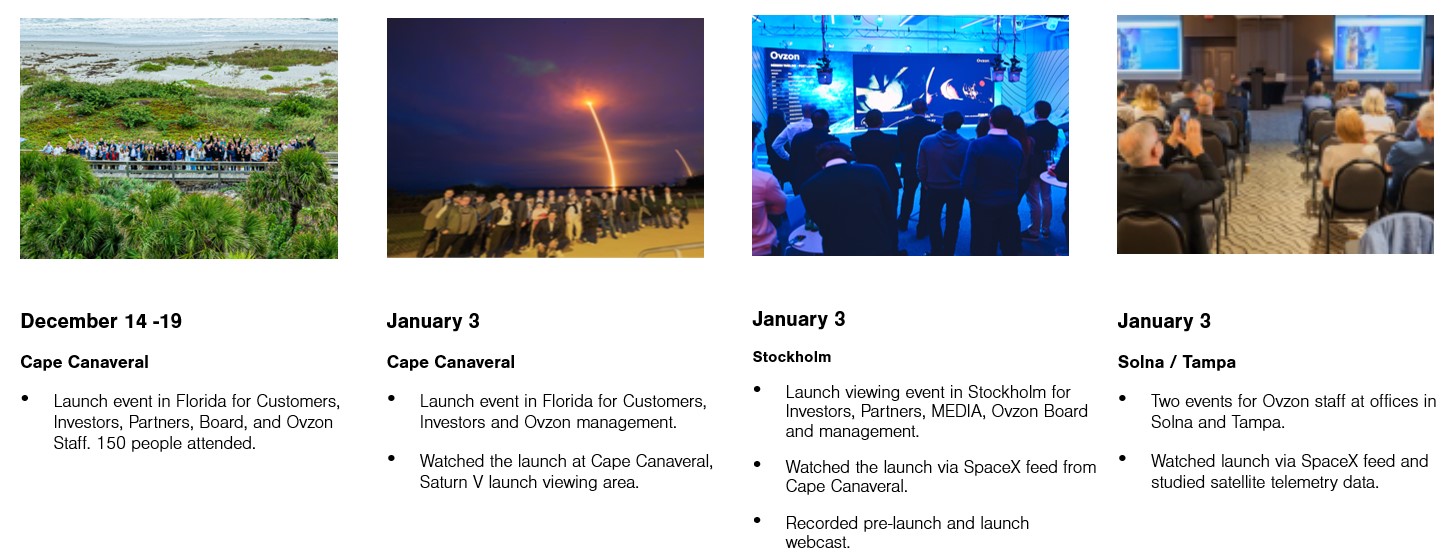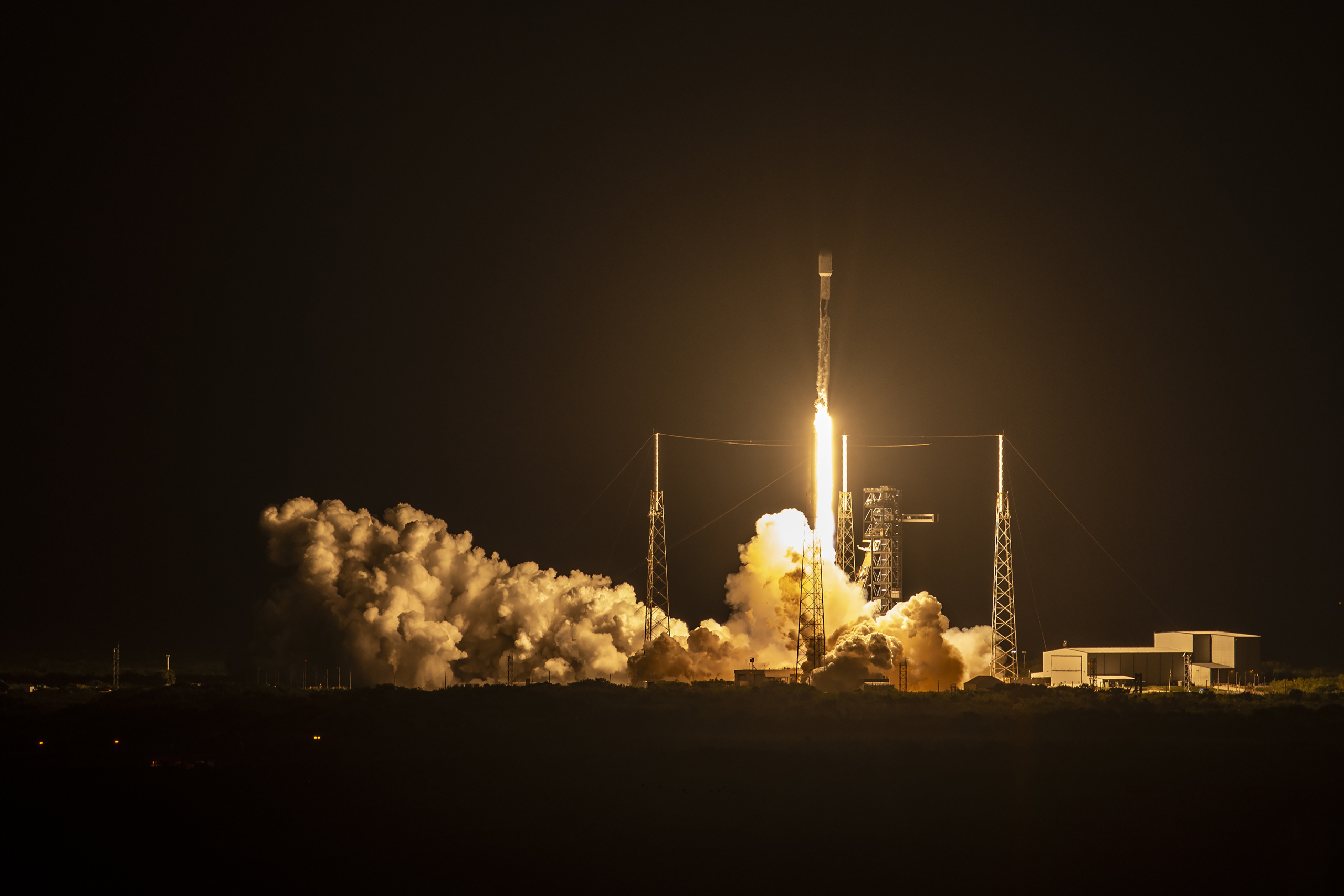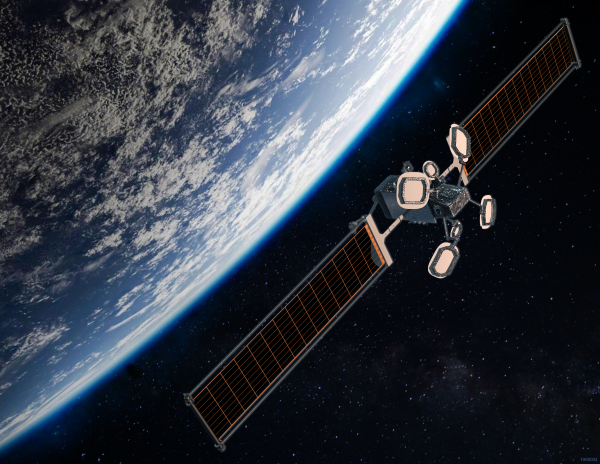Since its founding, Ovzon’s objective has been to deliver the most advanced, high-performance, and resilient mobile satellite-based communication service to its customers. In its continual, in-depth dialogue with customers and trusted advisors, the company has combined these insights and requirements with its own insights, experiences, and unique technology. This has led to the design and development of a new generation of satellites with integrated leading-edge technology. All this to be able to deliver the highest performing, unique, and resilient industry-leading satellite communications services – Ovzon SATCOM-as-a-Service – to Ovzon’s customers.
Ovzon 3 was successfully launched on January 3, 2024, from Cape Canaveral, Florida, using a SpaceX Falcon 9 rocket. The launch of Ovzon 3 is the most important milestone to date in the company’s history. The satellite is now on track toward its GEO orbit position of 59.7E, which it is planned to reach in mid-2024. The satellite’s movements in real-time can be tracked; there are several good tracking websites, and the satellite can be found by using either its NORAD ID (58698) or its name, Ovzon 3.
The launch of the satellite will enable Ovzon to significantly ramp up its position in the market while continuing to offer its current market-leading Ovzon SATCOM-as-a-Service. Ovzon will continue to offer services based on leased capacity, but once Ovzon 3 becomes operational in mid-2024, it will strengthen the company´s offering by adding more unique Ovzon 3-based services, thereby ensuring that Ovzon maintains and strengthens its leading position in the market.
Successful launch on January 3, 2024
The preoperational work to enable the launch of Ovzon 3 consisted of hard work by the company’s employees in teaming with the partners Maxar and SpaceX. Ovzon used the launch to highlight this milestone together with customers, partners, investors, media and employees. In December, the company gathered over 150 stakeholders for the planned launch in Florida. Even though unfavorable weather prevented the witnessing of the actual launch at that time, it was a unique opportunity to emphasize all the benefits of the company’s new technology and solutions platform. When the launch took place on January 3, a smaller VIP launch event in Florida was arranged, as well as viewing events in Sweden and the USA.

Advantages of a proprietary satellite:
Leased regional satellite
Proprietary satellite
With proprietary satellites, Ovzon’s patented technology can be fully utilized.
1. Increased control
With a proprietary satellite, Ovzon’s customers can choose which portion of the Earth’s surface their satellite-based communication will cover. This makes the service better adapted to customers’ specific needs. Ovzon’s design of the satellite for SATCOM-as-a-Service means the technology and the satellite’s unique ability are adapted to both current and future customer needs. Ovzon will be able to provide flexible and rapid steerability of the satellite’s coverage area. Moreover, the regulatory conditions for rapidly shifting and steering the satellite’s coverage area have been taken into account.
2. Faster, more efficient service
Ovzon’s satellite-based communication services are already significantly faster and more efficient than its competitors’. With Ovzon-owned satellites, data transfer, communication speeds, and efficiency can increase in the SATCOM-as-a-Service offering.
3. Smaller and lighter mobile satellite terminals
Ovzon’s mobile satellite terminals, developed in-house, are currently the smallest, lightest, and most user-friendly on the market. Both the first generation of mobile satellite terminal, Ovzon T5, and the current industry-leading terminal, Ovzon T6, are comparable in size to a laptop. Ovzon 3 is designed with the end user in mind, and therefore contains unique integrated technology for secure and efficient communication both via satellite and on the ground. In 2022, the work continued on developing the next mobile satellite terminal, which will be even smaller and lighter and will contain unique technology specifically adapted to the Ovzon 3 satellite. Ovzon will launch this new mobile satellite terminal, Ovzon T7, in connection with Ovzon 3 going online.
4. New revolutionary functionality
With Ovzon 3, the company introduces its On-Board Processor (OBP), developed in-house, which functions as the central hub of the satellite. The OBP will make it possible to offer the following trailblazing functionality:
• The use of Ovzon’s mobile satellite terminals as temporary teleports/gateways, meaning the part of the communication chain that connects the signal to the terrestrial network (e.g., the internet).
• The facilitation of “single-hop communication,” which involves a user on the ground being able to communicate directly with another user via the satellite.

Ovzon’s new on-board processor
With Ovzon 3, Ovzon introduced the industry’s first software-defined On-Board-Processor with unique capabilities to support customer requirements.
Ovzon On-Board-Processor is the next generation of proprietary and software-defined data processor in space. It facilitates new applications and unique functions that will allow Ovzon’s customers to benefit fully from Ovzon’s SATCOM-as-a-Service solution. The On-Board-Processor architecture facilitates mesh networks and single-hop communication among Ovzon’s mobile satellite terminals, such as the Ovzon T7. The architecture is distributed across several steerable beams, with minimal delay and full data rates on uplink and downlink. Customers can thus maintain a simultaneous, direct, and secure connection with a gateway and other users, regardless of whether they are in the same or different coverage areas on the ground.
Stability and reliability are keywords and properties that characterize the design. Encrypted monitoring and control links form the foundation of a secure, nominal network setting while a fully autonomous state can be activated for scenarios where no terrestrial connection other than the user network is available or desired. The system supports features such as frequency-hopping to counteract jamming and use in environments without GPS coverage.
The On-Board-Processor platform can be reconfigured and reprogrammed in orbit, which makes the Ovzon service future-proof, and new functions can be activated as customer needs develop over time.
In addition, the next generation of satellite terminals – Ovzon T7 – has a built-in modem (On-Board-Processor compatible) to benefit fully from the advanced functions in the Ovzon On-Board-Processor.

Ovzon’s new on-board processor Functions include:
• Single-hop communication
• Cross-connections and routing within and between steerable coverage areas
• Encrypted control links
• Autonomous state
• Frequency-hopping


